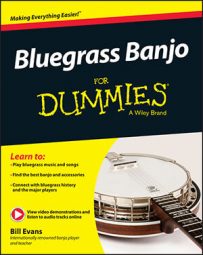There never seems to be enough time to play bluegrass banjo! When you do finally get the chance to sit down with your instrument, you want to be sure that you’re making the very best use of your effort by practicing those things that will transport your playing to the next level as quickly as possible.
Sweat the details
Bluegrass banjo is a demanding musical art form characterized by precision and speed. Whether you’re a beginner or a more experienced player, it’s essential to discover and adopt great picking‐ and fretting‐hand positions and playing techniques to bring out the best in your playing.
The secret to playing fast is to first sound great playing slowly. You want to have every roll note and fretting technique in place before gradually increasing speed.
Take it step by step
It’s tempting to want to tackle some of the most challenging songs as performed by your banjo heroes. But you’ll become a better player more quickly by trying out songs and arrangements that match your current ability level. Better yet, work on tunes and techniques that are just beyond what you’re capable of comfortably playing right now. If you’re a new player, stick to easier tunes and arrangements, and add a few new licks and techniques with each new song you play.
Find a good teacher
There are more ways than ever to access banjo information these days, but nothing replaces a great one‐on‐one instructor to help guide your development as a banjo player. A good teacher will direct you to the right things to work on at the right time and help you chart a course through the sea of instructional materials that are out there.
Begin your search for a teacher by contacting your local music store or a regional store that specializes in bluegrass music. In addition, many nationally known banjo players offer one‐on‐one online lessons via Skype. Subscription‐based online video lessons are an affordable option that allows you to access a large body of materials that you can study at your own pace.
Play with others
You’ll progress much more quickly in your banjo playing — and have an absolute blast doing it — if you can play with other musicians as much as possible. Bluegrass festivals and music camps are designed to bring together musicians of all experience levels to enjoy music making.
If you can pick a few roll patterns and change chords without stopping, you’re ready to find a jam session!
Use the metronome
Understanding how roll patterns and other techniques fit into the timing of songs is essential to good banjo playing, especially when playing with others. The best musicians in the world keep a metronome close at hand to ensure that they’re playing in good rhythm when practicing.
For most musicians, the trickiest aspect of using the metronome is figuring out how to get started. Before you begin, you need to decide how many roll notes will equal one metronome click. Most banjo players choose to play two roll notes for each click when first learning a song, setting the metronome at a speed that’s slow enough to play the song well.
Flow with your rolls
In a bluegrass band or jam session, playing with good rhythm is everyone’s responsibility. For banjo players, this means keeping an uninterrupted stream of steady roll notes emanating from your picking hand, no matter what moves your fretting hand may have up its sleeve.
Playing without stopping can be a big hurdle for beginners, which is why isolating this skill in practice sessions is important.
Listen, watch, and learn
You can put in practice time even when the banjo isn’t in your hands. Spend as much time as you can listening and watching your favorite players, and analyze what you’re seeing and hearing. As you observe others play, note the different techniques that are used to accompany singers and other instrumentalists. As you actively listen, you’re internalizing what the banjo is supposed to sound like, and in the process, you’re understanding more about bluegrass banjo style.
As you watch others play, take in as many fine details as you can. If you have a long commute, make daily listening to great recordings a part of your rush‐hour routine.
Use your ear more than tablature
When bluegrass musicians come together to play, they leave their music stands at home. Banjo tablature is designed to convey an amazing amount of detailed information, but when it’s time to make music with others, you have to set the tab aside and rely on your ear to react musically to what’s happening around you.
Each time you begin to work on a new song, find a good recording and get the sound of the tune in your head before investigating the tab.
Practice using looping techniques
One of the most efficient ways to make quick progress on the banjo is to repeat small phrases and licks over and over again until you’re playing them well.
Looping techniques allow you to play faster and memorize pieces more quickly. When you break down a song into its constituent licks and phrases, you’re also gaining insight into how melodies are assembled in bluegrass banjo style and how licks can be used in different songs. Looping prepares you for creating your own solos as you internalize the licks and phrases you encounter when you practice in this way.
Track your progress
It’s gratifying to listen to a recording you made of your playing six months ago and realize how much better you sound today. Keeping a record of what you play can help focus your practice efforts and allow you to feel good about all that you’ve accomplished on the banjo.
Dare to record yourself as often as you can stand it. Listen critically, but don’t beat up on yourself. Use what you hear to set new goals and get back to playing more banjo!

